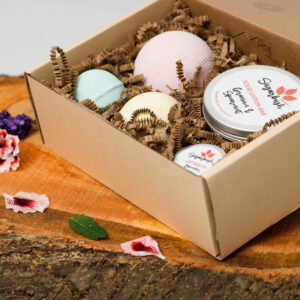Essential oils have become incredibly popular over the past decade and it’s easy to see why. They’re beautifully aromatic, naturally derived and incredibly versatile. They’re equally effective at creating a cosy home environment as they are at supporting skincare, cleaning and emotional concerns.
As lovely as they are, essential oils must be used with care, especially when applied to the skin. As a formulator (and a student of Formula Botanica), I believe it’s important to understand the difference between natural fragrance, synthetic fragrance, safety limits and how to use these potent extracts responsibly.
This week’s blog takes a gentle dive into the world of essential oils. I’ll be giving you an insight into what they are, how they differ from fragrance oils, safe dermal limits, common allergens and a few simple ways to enjoy them at home.
What are essential oils?
Essential oils are highly concentrated aromatic compounds extracted from plants. They are typically obtained through steam distillation or cold pressing (the latter is unique to citrus peels).
They contain hundreds of chemical compounds responsible for a plant’s scent and, in some cases, protective or pollinator-attracting properties. Essential oils can come from:
• flowers (lavender, geranium)
• leaves (eucalyptus, rosemary)
• resins (frankincense, copaiba)
• peels (orange, lemon)
• fruit (juniper, May Chang)
• needles (fir, cypress)
• wood (camphor, sandalwood)
• bark (birch, cinnamon)
• roots (ginger, vetiver)
• seeds (cumin, caraway)
Because they’re concentrated, a little goes a very long way. One drop of an essential oil can contain the aromatic equivalent of several handfuls of plant material. Their small molecular structure also makes it easy for active compounds to pass through the layers of the skin.
Essential oils vs Fragrance oils – What’s the difference?
It’s common to see essential oils and fragrance oils used interchangeably, but they’re not the same thing.
Essential oils
• 100% natural
• Extracted from plants
• Contain complex, naturally occurring chemical compounds
• Can have aromatic or therapeutic effects
• Require careful dosing in skincare
Fragrance oils
• Usually synthetic (though some include natural isolates)
• Created to mimic scents (vanilla, rose, cotton etc.)
• More stable in soap and candles
• Often longer lasting
• Not all are suitable for skincare – only cosmetic-grade fragrances approved for dermal use should be used.
Neither is “better”, they simply have different uses. At Sugarbush, I use essential oils for their natural aroma and their synergy with botanical ingredients – it’s what my brand is all about. I want your skincare to not only smell wonderful, but also provide the benefits offered by these natural compounds.
Safety considerations: Dermal limits in skincare
This is the part some brands gloss over, but as a trained formulator, it’s something I’m passionate about sharing.
Essential oils, while natural, are incredibly potent. There are frameworks set out by IFRA (the International Fragrance Association) that provide guidance for safe use in cosmetics. These limits are based on scientific review of skin sensitivity and allergen exposure.
In general:
• leave-on products (lotions, creams, balms) require lower essential oil percentages
• wash-off products (soaps, scrubs) can tolerate slightly higher amounts
• essential oils should never be applied neat to the skin
• pregnancy, sensitive skin and certain medical conditions require extra caution
Some naturally occurring components in essential oils also have their own specific safety limits. At Sugarbush, all my products are assessed by a specialist cosmetic safety company to ensure every formulation falls within safe limits. This sometimes means a milder scent (our Spearmint Lip Balm is a good example), but it ensures everything is safe and gentle to use.
Common allergens found in essential oils
Even natural ingredients can trigger allergies and essential oils are no exception. Essential oils contain components that must legally be listed if present above certain levels.
Some of the most common naturally occurring allergens include:
• Limonene (citrus oils, rosemary)
• Linalool (lavender, coriander, basil)
• Citronellol (geranium, rose oils)
• Geraniol (geranium, rose, palmarosa)
• Eugenol (clove, cinnamon, ylang ylang)
This is why you’ll see allergen declarations on Sugarbush labels and other cosmetic products containing natural essential oils. Transparency and safety always come first.
How to use essential oils at home
Here are a few gentle and safe ways to bring essential oils into your everyday routine:
1. Diffusing
Add 3–5 drops to a diffuser to create a calming or uplifting atmosphere. Avoid diffusing continuously for long periods. Short intervals are best. Be cautious of using this method if you have pets as some essential oils are toxic to them.
2. Room or linen sprays
Use a solubiliser to safely blend essential oils with water (never mix essential oils and water alone – they won’t combine). Spritz lightly on fabrics or into the air.
3. Bath scents
Mix essential oils with a carrier oil before adding them to a bath. Essential oils should never be added directly to water, they float on the surface and may irritate the skin. The Tisserand Institute has a great guide on bath safety with essential oils that you can access here: https://tisserandinstitute.org/safety/bath-safety/
4. DIY cleaning
A few drops of lavender, tea tree or lemon essential oil can boost natural cleaning sprays.
5. Skincare
If you’re formulating at home, follow IFRA dermal limits strictly and always dilute essential oils in a carrier oil. Never apply them neat. Formula Botanica regularly run mini courses that are free and are a great introduction to making your own skincare.
If you’re looking for further information of Essential Oil safety, the Tisserand Institute has an article on it here: https://tisserandinstitute.org/safety-guidelines/. Essential Oil Supplies also has a series of information booklets if you’re interested in dipping your toes into the world of essential oils: https://essentialoilsupplies.co.uk/collections/education-ek-series-booklets-brochures
Simple essential oil blends to try
Here are a few beginner-friendly blends that smell gorgeous and are easy to use in a diffuser or cleaning recipe.
Calm & Unwind
• 2 drops lavender
• 1 drop geranium
• 1 drop bergamot
Fresh & Focused
• 2 drops rosemary
• 1 drop peppermint
• 1 drop lemon
Cosy & Comforting
• 2 drops sweet orange
• 1 drop cinnamon leaf (NOT cinnamon bark)
• 1 drop cedarwood
Winter Clean Home
• 2 drops lemon
• 1 drop eucalyptus
• 1 drop tea tree
Always start with low amounts and adjust to preference.
You can get essential oils from the following suppliers:
Naturally Thinking https://naturallythinking.com/ or The Soapery https://www.thesoapery.co.uk/
Final thoughts
Essential oils are one of nature’s most beautiful gifts and can have a profound effect on our senses, from the uplifting freshness of citrus to the invigorating aroma of rosemary. But they’re also potent and must be used with knowledge and respect.
Whether you enjoy them for relaxation, a cosy home or gentle skincare, taking the time to use them safely ensures you get the very best out of them.
At Sugarbush, every essential oil blend is crafted with care, precision and strict adherence to safe usage limits so you can enjoy natural beauty with complete peace of mind. If you’d like to explore the essential oils I use, you’ll find them in most of my products – all handmade in small batches with safety and luxury at their core.






